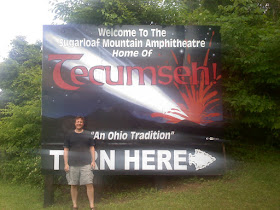We all know that John Cleves Symmes was a Judge and the surveyor of most of the SW Ohio area between the Great Miami and Little Miami Rivers in the late 1700’s known as the Symmes Purchase...right? There are roads, businesses, schools and a township named for him so you should at least recognize the name. In case you are unaware, his job was to hire folks to measure out the Ohio Valley into property to would be settlers for a low low price so that it could be developed into settlements for the budding US. Well, this isn't about THAT John Cleves Symmes. I'll leave him for a different post...
Judge Symmes had a nephew, also named John Cleves Symmes, who believed the Earth was basically hollow like a shell, we lived on the outside, but the inside had a delicious nougat center. Actually, he thought the inside was a series of nested hollow spheres inhabited by others and he wanted to visit there to prove it.
The idea of a hollow Earth wasn't really that crazy in the early 19th century and had been proposed by ancient philosophers as well as scientists such as British astronomer Edmund Halley
wasn't really that crazy in the early 19th century and had been proposed by ancient philosophers as well as scientists such as British astronomer Edmund Halley of comet fame and the mathematician & physicist Leonhard Euler
of comet fame and the mathematician & physicist Leonhard Euler .
.
In Hamilton Ohio there is a monument to Symmes and his theory at his grave site. I visited there with my friend and fellow geocacher Mark Fischer (& son) in May of 2010. I likely would have never known about this had it not been for the geocache nearby that brought us here.
The idea of a hollow Earth
In Hamilton Ohio there is a monument to Symmes and his theory at his grave site. I visited there with my friend and fellow geocacher Mark Fischer (& son) in May of 2010. I likely would have never known about this had it not been for the geocache nearby that brought us here.
**this sentence is pure speculation on my behalf, but Jackson did hate American Indians something fierce
 |
| plaque added that mirrors faded inscription |
Americus Symmes' tribute to dear old Dad
|
A follower named Jeremiah Reynolds finally did help persuade Congress to fund an expedition after Symmes' death and the resulting 1838 US Naval "Wilkes Expedition" ended up discovering a new land mass rather than just ice where Antarctica is. So, in effect, Symmes Hollow Earth theory led to the discovery of our 7th continent. Sorta.
His son Americus Symmes erected this monument in 1873 at his grave site. The inscriptions on the monument have been worn down over the years and plaques have been added that reproduce the words. There was a larger cemetery here at one time but for some reason, many of the people buried in this cemetery were re-interred in a larger place nearby. Symmes Jr still remains in this tiny fenced plot which is surrounded by a city park and playground. I'm sure the kids that playing with their hollow sphere basketball near the monument have no idea what's going on 300 feet from them.
I declare the earth is hollow and habitable within; containing a number of solid concentrick spheres, one within the other, and that it is open at the poles 12 or 16 degrees; I pledge my life in support of this truth, and am ready to explore the hollow, if the world will support and aid me in the undertaking. - John Cleves Symmes Jr., 1818
See more pictures of the monument here


























